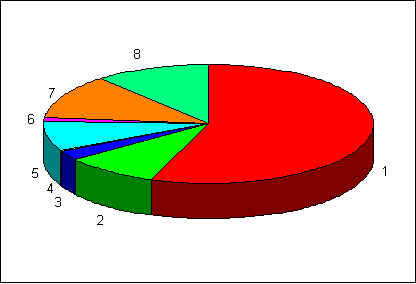Woodland Restoration Project
|
| Figure 10. proportional representation of area covered by different moss species in square 3. ( Numbers correspond to species numbers in Table 2) |
| Figure 10 illustrates the proportion of the
total area covered by mosses, accounted for by individual species. The area covered by
different species was generally fairly small (Table 2),
indicating early stages in the colonization process. Substantial invertebrate communities
were present in all the mosses growing on the woodland floor.Mosses occurred at ground
level in only one other area of the project site. Moss (mainly two species, Isothecium
myosuroides and Hypnum resupinatum) occurred on the flints on the woodland
floor in square 1. Although light levels were higher in square 4, than in square 1 (Fig.9), mosses were not found in the ground layer in this area. It is possible that this is due to the fact that no stones were available to act as a substrate in square 4. Isothecium myosuroides was found growing directly on soil in square 3, indicating that the stones are not obligatory as a substrate (Table 2). However, the moss here was completely covered in leaf litter and had the rhododendron still been present, as in square 4, light levels would presumably be too low for survival. The presence of stones and rocks in square 1 allows the moss to grow on a substrate raised above the level of the leaf litter and fully exposed to whatever light is available. Other plant species besides mosses have begun to colonise the bare woodland floor in the region previously cleared of rhododendron (square 3). Seedlings of brambles, an as yet unidentified sedge, ivy, foxgloves and bedstraw occurred in this region (Table 1). Plants were few and far between. The density for most species was in the region of 0.05 individuals per m 2. The sedge was the most common species, with a density of 0.4 individuals per m2. It was not identified because of the juvenile size of the plants and also. without flowers, it is often difficult to identify the species with any accuracy. (The survey was carried out in November, when there are not even the remains of the previous years flowers left on the plants to aid identification.) It will be identified to species level at a later date.Although the rhododendron has been largely cleared from this area, regenerating stumps remain and new seedlings are growing up (Plate 13). The overall density was 0.85 rhododendron plants per m 2. Average height of the plants was only 20 cm, but the potential remains for the rhododendron to once more dominate the area if not kept in check. |
